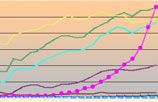Partners join forces in 'belt and road' project
By Kheng Swe Lim (Chinadaily.com.cn) Updated: 2015-03-18 14:35An economically integrated ASEAN will also be a welcome investment destination for China, because it would present opportunities for Chinese companies to invest and grow.
Nevertheless, as with any project as ambitious as the 21st Century Maritime Silk Road, China is likely to face obstacles on the way. So, two particular issues need to be addressed.
The first is the lingering tensions over maritime disputes in the South China Sea, although the situation has been relatively calm over the past year. More importantly, the tensions have not been allowed to affect Sino-ASEAN economic ties, and thus should continue to be carefully managed so that they do not harm them in the future too.
The second possible obstacle China faces is the impact of the 21st Century Maritime Silk Road project on ASEAN-centered integration. The project could create the impression that China is replacing ASEAN as the driver of regional affairs. This could cause worries within ASEAN over losing its central role in regional affairs.
Hence, the ASEAN member states will want to see how the 21st Century Maritime Silk Road unfolds, for they want to fully understand the details of the plan and the benefits they can derive from them. Fortunately, there is a fundamental synergy between the interests of both sides.
It is possible to build on the pre-existing regional architecture, and China and ASEAN can easily find common ground between their respective visions of regional integration. For example, the 21st Century Maritime Silk Road project can boost ASEAN’s attempts to build the ASEAN Economic Community. The current attempts to renegotiate the CAFTA can also be read within the broader philosophy of the “Belt and Road Initiatives”, as can the Regional Comprehensive Economic Partnership negotiations.
The “Belt and Road Initiatives”, therefore, would benefit both sides as they are broad enough to encompass different modes of economic integration. And such attempts will reassure ASEAN that its role remains central to the regional architecture.
The author is a research analyst at RSIS China Program, Nanyang Technology University. The opinion is the author’s own view.











